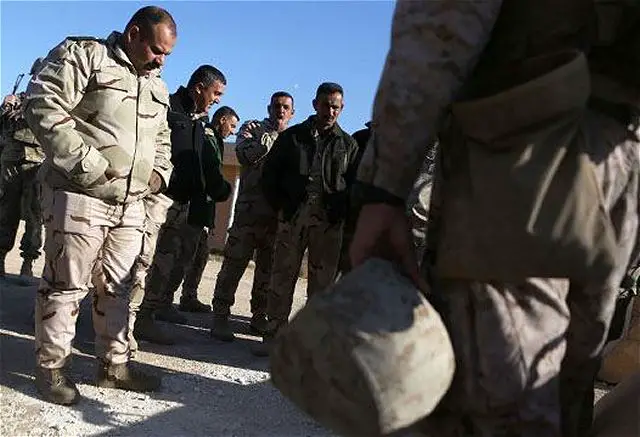|
U.S. Marines to train Iraqi soldiers
|
|||
|
|
|||
|
|
|||
| U.S. Marines provide C-IED Counter-Improvised explosive device training to Iraqi soldiers. | |||
|
U.S. Marines and Danish soldiers with Task Force Al Asad gave Iraqi leaders counter – improvised explosive device training aboard Al Asad Air Base, Iraq, Jan. 31, 2015. The training allowed the Iraqi brigade and battalion-level staff members to experience what their soldiers were learning and would be tested on. The staff received the same formal instruction Marines receive when learning how to combat IEDs.
|
|||
|
|
|||
 U.S. Marine Chief Warrant Officer 2 Juan Rodriguez, an explosive ordnance disposal officer with Task Force Al Asad, and brigade-level leaders of the Iraqi Army walk through an improvised explosive device training lane aboard Al Asad Air Base, Iraq, Jan. 31, 2015. U.S. Marine Chief Warrant Officer 2 Juan Rodriguez, an explosive ordnance disposal officer with Task Force Al Asad, and brigade-level leaders of the Iraqi Army walk through an improvised explosive device training lane aboard Al Asad Air Base, Iraq, Jan. 31, 2015. |
|||
|
|
|||
|
U.S. Marine Chief Warrant Officer 2 Juan Rodriguez, an explosive ordnance disposal officer said, “They specifically asked for C-IED training [because] they understand what the primary threat is.”
“We tried not only teaching them what their soldiers are going to learn, but how to take that C-IED mindset and input it into their mission planning process,” added Rodriguez, a Buena Park, Calif. native. Understanding the material and participating in the same training their soldiers receive can help leaders be more effective. “They need to [experience] the training for themselves,” said Rodriguez. “They need to understand what their soldiers are encountering on the ground. It will only enhance their planning process for operations and missions.” Many of the Iraqi staff had experience from their past years of service so they already understood much of the material. “I think they already have a good understanding of IEDs,” said Rodriguez. “Today we also brought them up to speed on what Daesh is doing.” Rodriguez added the trainees were also learning how to mitigate the threat of IEDs. After teaching the functional aspect of IEDs, Rodriguez stressed the importance of safety in an area where there may be potential threats. Rodriguez said, “We emphasized good reporting procedures, encouraging their soldiers not to touch anything, to back off and set up a cordon, and things of that nature.” “Once we got them into the IED lanes, they got a lot more involved,” said Rodriguez. “They had a lot more input. I saw a lot of the older, more experienced [soldiers] providing their personal input which is good to see that mentorship taking place.” Once the new Iraqi soldiers learn the basics, more advanced training can be taught. “There’s going to be a six-week, engineer-specific course,” said Borch. “It’s going to be a lot more focused on search and C-IED. It will give them the ability to really do something about [an IED threat].” The Iraqi leaders were enthusiastic about being able to participate in the practical application portion of the training. They walked away with a better understanding of what their soldiers were taught, and what their new capabilities are. |
|||
U.S. Marines provide C-IED Counter-Improvised explosive device training to Iraqi soldiers
- Posted On














